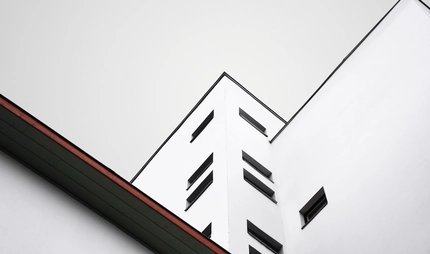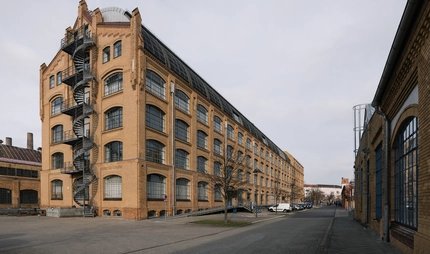
Bundesschule des Allgemeinen Deutschen Gewerkschaftsbundes (ADGB)
Progress in stone, steel, and glass
The Federal School of the General Confederation of German Trade Unions (ADGB) in Bernau near Berlin stands in the building landscape in and around the capital for the progress and technology of Berlin's modern age. It is a work of the world-famous Bauhaus and is a UNESCO World Heritage Site.
The Bauhaus was the most important school of design, architecture, and art in the 20th century. Nearly 100 years ago, the designers, architects, and visionaries of the Bauhaus created powerful ideas that have had a lasting impact around the world.
The Bauhaus Ideal
The school in Bernau was completed in 1930 for the General German Trade Union Confederation with the substantial contribution of Hannes Meyer, then director of the Bauhaus, and Hans Wittwer, then master of the construction department and head of the construction office at the Bauhaus.They created an exemplary design for a facility with clear lines set in a natural landscape on the edge of Berlin.
Award-Winning World Heritage
The building complex has been a protected monument since 1977 and was just named a UNESCO World Heritage Site in July 2017, joining other Bauhaus UNESCO World Heritage Sites in Dessau and Weimar. The school has now almost been completely restored in its original state. The restored Bundesschule was awarded the Brandenburg Architecture Prize in 2007 and baudenkmal bundesschule bernau e. V. was awarded the Brandenburg Built Culture/Initiative Prize in 2015 for its efforts to save the Bundesschule.
Unique Architectural Aspects
Nine components now form the historic complex: the entrance, the auditorium, the dining hall, a glass corridor, boarding houses, a sports hall, seminar rooms, teachers’ houses, and the library. While the entrance and some other parts of the ensemble were significantly modified in the 1950s, most parts of the building were restored in 2001-2007 to the original colour scheme and visual language that the Bauhaus is famous for.
Especially impressive is the faithfully restored dining hall with its graceful, ribbed concrete design and the giant chandeliers made of hundreds of glass blocks. The glass corridor is once again flooded with light and serves as the dominant axis of the building and as a place of communication. Classically Bauhaus: the stairwells in the different boarding houses have been given different colour schemes.
The way the rooms are divided, the refined lighting scheme, and the way the bathrooms, social spaces, and communication areas are designed reflect the progressive and democratic teaching and learning traditions of the Bauhaus. The rooms near the artificial pond and outdoor swimming pool open out onto views of this open space. The sports hall can even be almost completely opened on one side.

The History of the Bundesschule
Weimar Republic
When the ADGB Bundesschule opened in 1930 as the first central training centre for the trade unions and the ADGB, it offered space for 120 participants. Courses for youth leaders,works councils, labour dispute judges, etc. were offered. In the few years before Adolf Hitler was elected chancellor, more than 4,000 trade unionists took courses here, 15-20% of whom were women. The teachers taught basic knowledge on social policy, economic policy, and labour law, while representatives of the respective associations provided information about organisational and trade-specific problems, history, and current political issues. The school also offered “practical exercises”, “written work”, and “sport and body care”. Obligatory cultural events usually followed in the evening hours. With this concept, the school stands in the tradition of trade union education as practised in Germany since the beginning of the 20th century.
The Federal School under National Socialism
On 2 May 1933, the Berlin wing of the SA (Storm Troopers) occupied the Bundesschule. The students were forced to leave. On 16 June 1933, the school was converted into the Reichsführerschule (Reich Leadership School) of the Nazi Party and the German Labor Front (DAF) and was personally inaugurated by Adolf Hitler. This was where the top officials of the Nazi Party, the DAF, and the NSBO (the Nazi successor to the trade unions) were trained. Well-known Nazi representatives like Propaganda Minister Joseph Goebbels, ideologue Alfred Rosenberg, editor of the anti-Semitic weekly newspaper Der Stürmer Julius Streicher, and DAF head Robert Ley held lectures here. The instruction had a military flavour. A shooting range and war games facilities were built on the school grounds. Between 1941 and 1943, the Reich Main Security Office (RSHA) met here to consult on racial policy, deportation, and resettlement policies.
Postwar and GDR
After the end of the Second World War, the Soviet Military Administration and the Red Army used the site as a hospital and military accommodation. But the newly founded Free German Federation of Trade Unions (FDGB) asserted its claim to the facility by the end of 1945. It was returned the following year and opened in 1947 as the Theodord Leipart FDGB Bundesschule, rechristened in 1952 the Fritz Heckert Trade Union School. The training offered here now offered a diploma. Professors and institutes were set up for such subjects as political economics, business administration, social policy, labour law, history of the German and international labour movement, and the philosophy and cultural policy of the trade unions in the East.
Post-Communist Era
When the FDGB was dissolved along with the rest of East German institutions in 1990, the school was also closed and all its employees dismissed. The ownership and future use of the listed building and its campus would remain uncertain until 2001 when the Berlin Trades Chamber became the new owner entitled to use the site. Today, the buildings of the former Bundesschule serve as a hotel hosting courses and training workshops for the Chamber. Both the historic and in newly built buildings are home to the BarnimWissensZentrum. It offers free, qualified professional training in state-recognised professions in business, administration, and social services.
Guided tours:
The Bauhaus ensemble can be visited during guided tours. Public events will also take place on the Open Monuments Day and for the Triennale der Moderne.
Access by public transport:
S-Bahn or regional train to Bernau (bei Berlin) and then by bus to Station Bernau, Waldfrieden.



